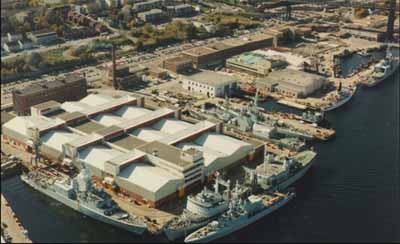Halifax Dockyard National Historic Site of Canada
Halifax, Nova Scotia

Aerial view
© Canadian Navy, Department of National Defence / Marine canadienne, ministère de la Défense nationale.
Address :
Barrington and Upper Water Streets, Halifax, Nova Scotia
Recognition Statute:
Historic Sites and Monuments Act (R.S.C., 1985, c. H-4)
Designation Date:
1923-05-25
Dates:
-
1758 to 1758
(Construction)
-
1917 to 1917
(Significant)
-
1760 to 1819
(Significant)
-
1775 to 1781
(Significant)
-
1812 to 1815
(Significant)
-
1914 to 1919
(Significant)
Event, Person, Organization:
-
American Revolution
(Event)
-
War of 1812
(Event)
-
First World War
(Event)
-
Mont-Blanc Halifax Explosion of December 1917
(Event)
-
Royal Canadian Navy
(Event)
-
Sir Provo Wallis
(Person)
-
Royal Navy
(Organization)
-
Maritime Forces Atlantic
(Organization)
-
Captain James Cook National Historic Person
(Builder)
Other Name(s):
-
Halifax Dockyard
(Designation Name)
-
HER MAJESTY'S NAVAL YARD
(Plaque name)
Research Report Number:
2009-CED-SDC-037
DFRP Number:
02919 00
Plaque(s)
Original Plaque: HMC Dockyard Barrington and Upper Water Streets, Halifax, Nova Scotia
Site secured to the Crown in February 1759.
The First Royal Dockyard in (present) British North America.
Here Captain James Cook.
The famous navigator and discoverer, was stationed in 1759, and superintended the erection of the first buildings.
The birthplace of Sir Provo Wallis, Admiral of the Fleet.
Of special importance during the American Wars 1775081 and 1812-15, and played a prominent part in the Great War 1914-18.
Description of Historic Place
Halifax Dockyard National Historic Site of Canada is located on the Atlantic shoreline at the north end of Halifax Harbour, in Nova Scotia. It is comprised primarily of wharfs, storage warehouses, and repair, servicing and docking facilities. As part of Canadian Forces Base (CFB) Halifax, the site is still in use as a naval depot, for berthing and servicing naval vessels. Official recognition refers to the Halifax Dockyard as it existed in 1923.
Heritage Value
Halifax Dockyard was designated a national historic site of Canada in 1923 because: it was the earliest Royal Navy dockyard in North America, being established before 1760; it was the scene of many of the greatest events in connection with British naval history on the North American continent.
Created in 1758, under the supervision of Captain James Cook, the Halifax Dockyard was the first royal dockyard in North America. From 1760 to 1815, Britain was almost constantly at war and the dockyard grew steadily in response to the needs of the Royal Navy. It served as the principle depot for the North American squadron until 1819, when it was replaced by Bermuda and became the summer rendez-vous point for the West Indies and North American squadrons. In 1905 the British left the dockyard and it was transferred to the Dominion of Canada five years later.
After the American Revolution, Halifax Dockyard became by default the oldest military harbour in British North America. Occupied by the Royal Canadian Navy, it retained its active military function and was pivotal to strategic defence in the American Revolution, the War of 1812 and the First World War. Although numerous new buildings were added to the site during the First World War, the explosion of the Mont Blanc in Halifax in 1917 destroyed many of the structures. Under the control of Maritime Atlantic Forces (MARLANT), the Halifax Dockyard continues to be used by the Canadian navy.
Sources: Historic Sites and Monuments Board of Canada, Minutes, 1923; Plaque Text, 1924, 1980.
Character-Defining Elements
Key elements that contribute to the heritage character of the site include: its location along the shoreline of the Atlantic Ocean at the northern end of the Halifax Harbour in downtown Halifax, Nova Scotia; evidence of the original plan of the site dating from 1758 and of its evolution until the early 20th century, including its functional spatial organization; the surviving original location, function, design, form and materials of the remaining structures dating from the period between the establishment of the Dockyard and the early 20th century, notably the Dockyard Terrace; the integrity of any surviving or as yet unidentified archaeological remains associated with the establishment of the Halifax Dockyard and its role during many of the great events related to British naval history on the North American continent, both on land or under water, which may be found within the site in their original placement and extent; the continuing traditional functions and uses associated with the Dockyard; viewscapes between the dockyard and the surrounding landscape, notably the Atlantic Ocean.